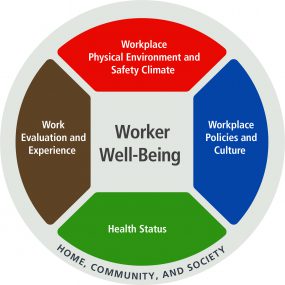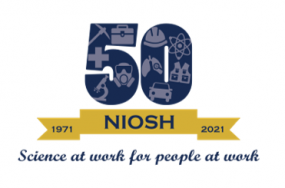Total Worker Health in Action: March 2021
Volume 10 Number 1 April 2021
Update on the Coronavirus Disease 2019 (COVID-19) Response
You can stay up to date on the COVID-19 response in real time on the COVID-19 webpage or sign up for the COVID-19 newsletter.
Director’s Buzz
L. CASEY CHOSEWOOD, MD, MPH
A holistic approach to worker well-being provides an important avenue to improve the safety and health of workers. Worker well-being is a focal point during the pandemic as workers operate under stressful conditions, adjust to changes in workplace policies and practices, and cope with many other complex issues. Before the pandemic, the value of worker well-being was emphasized by the U.S. Surgeon General, recommending that employers and companies implement worker well-being programs more broadly to meet workers’ needs.

The Total Worker Health (TWH) program aims to enhance worker well-being by informing the design of work and employment conditions in a way that will prioritize safety and improve physical and psychological outcomes. This newsletter features a unique new tool from NIOSH that will help employers and workplaces measure worker well-being. We also highlight examples of workplaces supporting workers’ well-being below. We encourage you to use the resources in this newsletter to support your workers and to share your own success stories as you promote worker well-being.
Total Worker Health Exclusive
New Tool to Measure Worker Well-Being: The NIOSH Worker Well-Being Questionnaire (WellBQ)
Total Worker Health is defined as policies, programs, and practices that integrate protection from work-related safety and health hazards with promotion of injury and illness-prevention efforts to advance worker well-being. Designing work to eliminate or reduce safety and health hazards and promote worker well-being is fundamental to a Total Worker Health (TWH) approach. The release of a new tool to measure worker well-being will help researchers, employers, workers, practitioners, and policymakers understand workers’ well-being and target interventions to improve worker well-being.
The NIOSH Worker Well-Being Questionnaire (WellBQ) is a freely available survey instrument that provides an integrated assessment of worker well-being across multiple spheres. These include workers’ quality of life, working conditions, circumstances outside of work, and physical and mental health status. The questionnaire measures worker well-being as a holistic construct rather than simply “workplace” or “work-related” well-being.

The NIOSH WellBQ comprises the five domains of worker well-being identified by NIOSH and the RAND Corporation in the article Expanding the Paradigm of Occupational Safety and Health: A New Framework for Worker Well-Being:
- Work Evaluation and Experience
- Workplace Policies and Culture
- Workplace Physical Environment and Safety Climate
- Health Status
- Home, Community, and Society
The questionnaire includes 68 questions representative of the five domains of worker well-being. Complementing these are 15 optional questions about demographic and employment information, which may be edited as needed to meet user interests. The draft NIOSH WellBQ was field tested in a nationwide sample of 975 people. Findings from the testing suggest that the final questionnaire takes about 15 minutes to complete.
Anyone interested in measuring the well-being of workers can use the NIOSH WellBQ. The questionnaire can be used to achieve specific goals, such as the following:
- Set benchmarks internal to an organization or workforce
- Assess the well-being of a group before, during, and after an intervention
- Compare results between groups within the same facility or workforce or across organizations or working populations
- Inform decisions to advance worker well-being in the workforce
To learn more about how the NIOSH WellBQ can be applied and for more information on how to administer the survey, please view these frequently asked questions and answers. Using the results of the NIOSH WellBQ, you can identify opportunities for advancing worker well-being through workplace policies, programs, and practices. These Resources for Action may help you address the issues identified from the results of the NIOSH WellBQ. Please reach out to the NIOSH TWH staff at twh@cdc.gov if you have questions.
L. Casey Chosewood, MD, MPH, Executive Editor
Emily Norton, Managing Editor
Sarah Mitchell, Associate Editor
Seleen Collins, Copy Editor
Margaret Bertsch, NIOSH Web Developer
Steve Leonard, NIOSH Web Publisher
Please send your comments and suggestions to us at twh@cdc.gov.
To receive the NIOSH TWH email newsletter, enter your email address:
Promising Practice
Creating a Culture of Health: The Semel Healthy Campus Initiative Center at UCLA

Editor’s Note: The NIOSH Total Worker Health program developed this article in collaboration with Meagan Wang, Wendelin Slusser, Alison Hewitt, Sapna Thottathill, and Gale Sheean-Remotto.
Recognizing that universities have the capacity and responsibility to infuse health and well-being into campus culture, “healthy campus” efforts have grown around the country, including at the University of California, Los Angeles (UCLA). In 2013, UCLA Chancellor Gene Block announced the Semel Healthy Campus Initiative (Semel HCI), envisioned and supported by Jane and Terry Semel. Semel HCI is now a Center at UCLA, partnering with diverse stakeholders across the campus to foster a culture of physical, emotional, and social well-being for the whole campus community.
The Semel HCI at UCLA has led the university in creating a culture of health on campus for more than 85,000 students, staff, and faculty. For nearly ten years, the Semel HCI has inspired others across the University of California (UC) system through the UC Global Food Initiative and the UC Healthy Campus Network.
Programs to Advance Worker Well-Being
To improve the culture of health in the workplace, Semel HCI leads various efforts. The initiatives outlined below integrate systems to advance worker well-being, which is fundamental to the Total Worker Health approach.
- Semel HCI’s podcast, UCLA LiveWell, addresses emerging and urgent needs presented by the pandemic. On the podcast, Associate Vice Provost Wendelin Slusser interviews leaders about how to take care of all dimensions of health and well-being.
- Last Summer, Semel HCI hosted a Health Equity Summit to discuss and strengthen a shared vision for fostering health and well-being and reducing health inequities at UCLA and beyond. Over 150 participants attended the virtual summit. Discussions from the summit catalyzed multiple efforts focused on health equity, including the development of a Health Equity Minor and the Semel HCI Health Equity Seminar Series.
- The UC Diabetes Prevention Program (DPP) is a free, year-long, group and education-based lifestyle intervention for those at risk of developing diabetes. In the 2019-20 academic year, Semel HCI supported a research project to understand the role of social support in UCLA’s DPP and to assess the program’s impact on participant health outcomes. In 2020, the DPP successfully pivoted to the virtual environment. Interviews completed with DPP participants revealed the importance of social connectedness gained from the program. The online format was found to facilitate more resource sharing, collaboration among coaches, and opportunities for staff to participate. To date, over 1,155 individuals have participated in UC’s DPP.
Next Steps: University of California Health and Well-being Incorporated in Policy
The Healthy Campus Network (HCN), inspired by Semel HCI, UC San Francisco Healthy Beverage Initiative, and the UC wide Tobacco Free Initiative, is a system-wide initiative that promotes innovative reforms in all dimensions of health and well-being “to make UC the healthiest place to work, learn and live.” The HCN is currently waiting for approval of a new section in UC’s systemwide Sustainable Practices Policy that focuses on the intersection of wellness and sustainability. This addition will provide a way to respond to health and social injustices magnified by the pandemic and current events and to highlight the critical intersection between climate, health, and equity. This new policy provides a commitment from the HCN to evaluate the UC Sustainable Practices Policy from a health equity perspective and to support intersectoral collaboration, identify co-benefits for partners, and engage with relevant stakeholders. The proposed policy commits the HCN to explore the integration of health and well-being in all practice policy areas, utilizing the Health in All Policies (HiAP) approach. The proposed policy commits the HCN to explore the integration of health and well-being in all practice policy areas, such as vending and beverages, utilizing the Health in All Policies (HiAP) approach.
Special Update from HealthiestNIOSH: A Year in Review
HealthiestNIOSH Uses TWH Strategies to Support NIOSH Workforce
Last year was a very challenging one for most people. On March 17, 2020, the Centers for Disease Control and Prevention (CDC), including NIOSH, implemented a 100% telework operating status in response to COVID-19. Although teleworking has benefits, such as shorter or nonexistent commute times, it can also be a hard transition for employees who have not worked from home in the past. To help with the transition, a NIOSH program called HealthiestNIOSH started developing activities, messaging, and resources to support staff. Here are the services and communications created to give NIOSH employees information, guidance, and opportunities for engagement and well-being.
- Guidance, Support, and Resources: Healthiest NIOSH sent over a dozen emails to NIOSH employees containing information, tips, and resources on how to navigate through some of the most challenging areas of work and life that are important to its workforce, such as these:

- Managing work schedules
- Staying active
- Working remotely/optimizing workspace
- Boosting your mood through physical activity
- Keeping tabs on your mental health
- Benefits of meditation
- Back-to-school considerations
- Virtual Engagement Opportunities: NIOSH offered virtual social events (The Match Game, Trivia, Halloween Costume Contest, and a Talent Show) during the lunch hour to further connect and support employees who missed the social engagement of the workplace.
- Virtual Fitness Workouts: The team also changed all in-person workouts to virtual workouts by April 2020. NIOSH offered over 30 types/styles of classes, hosting over 500 virtual fitness classes led by a certified fitness instructor via Zoom. NIOSH workers completed more than 4500 virtual workouts throughout 2020.
- Focused Webinars: HealthiestNIOSH sponsored several webinars to address the challenging times. Examples include “Thriving in Uncertain Times,” “Overcoming Compassion Fatigue,” “Managing Cumulative Stress,” and the “Power of Positivity.” The well-being webinars delivered 311 hours of employee training.
Although HealthiestNIOSH is still evaluating these promising programs, the organizational support tips and resources may be useful to other worksites where staff have transitioned to teleworking.
Spotlight on Opioids in the Workplace
Editor’s note: If you or someone you know needs assistance (in English or Spanish) with mental health concerns and/or substance use disorders, prevention, and recovery, please contact SAMHSA’s National Helpline at 1-800-662-HELP (4357) or visit https://www.samhsa.gov/find-help.
The Real Cost of Substance Use: Updated Tool for Employers
The National Safety Council (NSC) collaborated with an independent research institution to update “The Real Cost of Substance Use to Employers” tool. The Substance Use Cost Calculator for Employers is an easy-to-use tool that gives employers specific information about the cost of substance use in their workplace, based on size of employee base, industry, and state. Examples of substance use include prescription drug use and misuse, alcohol use and misuse, opioid use and misuse, and use of other illicit drugs and cannabis.
The tool gives a simple estimate of the financial toll faced by individual businesses and identifies an area with significant potential for cost reduction and improved productivity. It also helps businesses see how much they can save by supporting employees through treatment and into recovery.
NIOSH resources related to recovery-supportive workplaces provide additional information for employers and workers facing the challenges of substance use disorders.
Related Resources
News from NIOSH
NIOSH Celebrates 50 Years

This year marks the 50th anniversary of NIOSH. The Occupational Safety and Health (OSH) Act of 1970 established NIOSH as a separate and independent research program to pursue objective scientific research findings in the field of occupational safety and health. NIOSH created a limited time series of “NIOSH Now” and “NIOSH Then” to look back at research efforts inside and outside of NIOSH from the past 50 years. The January 2021 edition of NIOSH eNews highlights the “Early Steps Toward Integrating Workplace Safety and Health: Origins of Total Worker Health.” NIOSH will also be recognizing this important milestone through various channels throughout the year on the NIOSH website.
NIOSH Extramural Research and Training Program Annual Report Released
The FY2019 NIOSH Extramural Research and Training Program Annual Report is now available. This document provides information on how NIOSH invested in the Centers of Excellence for Total Worker Health® and other multidisciplinary centers, investigator-initiated research projects, and cooperative research agreements. It also reports on NIOSH training project grants, state surveillance programs, small business innovation research, and the World Trade Center Health Program’s extramural portfolio of cooperative agreements. For the latest information on NIOSH-funded extramural activities, visit the NIOSH Extramural Research and Training Programs web page.
NIOSH TWH Affiliate Program Reaches Milestone
The NIOSH TWH Affiliate Program recently celebrated an important partnership milestone, reaching 50 affiliates. Learn more about current affiliate activities and how to become an affiliate.
News from the NIOSH Centers of Excellence for TWH
- The Center for Health, Work & Environment (CHWE) is offering a 20-minute, self-paced training to help participants identify workplace design elements and best practices to improve health, productivity, and employee satisfaction. The online course Health-Promoting Workplace is designed for use in conjunction with the Health Links Healthy Work Environments Survey. CHWE also announced that the 15-credit hour TWH Certificate Program is currently accepting applications for the Fall 2021 semester, including scholarship opportunities. The program is now available to all applicants, not just current Colorado School of Public Health students.
- The Center for the Promotion of Health in the New England Workplace (CPH-NEW) will start offering a self-paced, online continuing education course, Total Worker Health for OSH Professionals. The course introduces TWH and how it applies to OSH professional practice. CPH-NEW is also offering a free, innovative opioid hazard awareness training module designed for sand and gravel workers. The Opioid Hazard Awareness Trainingcomes with a Facilitators’ Guide with slide-by-slide instructions including how to engage training participants through discussion.
- Investigators and researchers at the Harvard Center for Work, Health and Well-being are teaching “Work Health and Well-being: Achieving Worker Health.” This Harvard T.H. Chan School of Public Health Executive and Continuing Professional Education course provides participants with skills to implement policies, programs, and practices focused on working conditions impacting both worker and employer safety, health, and well-being outcomes. Participants will also learn to implement outcomes measurement programs and to assess the financial impact of integrated employee health programs, gaining the skills to make the business case for improving employee health. Learn more and register.
- The Healthier Workforce Center of the Midwest (HWC) continues to develop Workplace Matters podcasts, addressing emerging issues such as Mental Wellness and Diversity, Equity, and Inclusion in the Workplace. The HWC also developed several new videos for employers, including a recent video addressing the Multi-Generational Workforce.
- The Oregon Healthy Workforce Center (OHWC) and Oregon TWH Alliance are working to share partners’ experiences with TWH approaches. They developed case studies using information provided and approved by organizations. These case studies will be used in OHWC education sessions and trainings. This quarter, OHWC also released a new podcast, Part 3.1 Three Decades: Meet the Scientist, highlighting four Institute scientists. Their areas of research cover a variety of topics, like leadership and management, supportive supervisor behaviors, injury prevention for nurses in rural hospitals around Oregon, and TWH intervention programs.
- The University of Illinois (UIC)–Center for Healthy Work is studying substance use in the workplace. In a collaborative research study, the Center for Healthy Work is seeking to learn more about Boone County residents’ experiences with work and health, mental health, and substance use. In another study focused on workplace harassment, macro-level stressors, substance use, and health outcomes, researchers hope to increase public awareness of workplace harassment as a significant health risk. The study aims to develop a learning-based intelligent system that detects injury hazards that can occur while humans collaborate with robots at work. Visit the center’s website for more information.
These are just a few of the updates from the NIOSH Centers of Excellence for TWH. To learn more about each of the Centers and their response efforts, visit their websites.
News from NIOSH TWH Affiliates and Partners
Featured Affiliates: Get to Know the NIOSH TWH Affiliates
This new feature was created to introduce our readers to the current NIOSH TWH Affiliates. See how two NIOSH TWH Affiliates responded when we asked about their work. If your organization is a NIOSH TWH Affiliate and is interested in being featured, please email TWH@cdc.gov.
Association of Occupational Health Professionals in Healthcare (AOHP)
Learn more about the Association of Occupational Health Professionals in Healthcare!
University at Buffalo
Learn more about the University of Buffalo!
Affiliate Updates
Publications on work environments from the University of Southern California Center for Intelligent Environments
The University of Southern California Center for Intelligent Environments published two articles related to the health and well-being of office workers engaging in their environment. Impacts of Working from Home during COVID-19 Pandemic on Physical and Mental Well-Being of Office Workstation Users investigated the impacts of social, behavioral, and physical factors on the well-being of such workers. The article Intelligent Agents to Improve Thermal Satisfaction by Controlling Personal Comfort Systems Under Different Levels of Automation describes the testing of different levels of automation for thermal conditions where control is shared between an intelligent agent (empowered by machine learning algorithms) and the office worker to improve thermal comfort and satisfaction in office workspaces.
Safety Fest of the Great Northwest Boise
Safety Fest of the Great Northwest Boise is an annual training event that offers free safety and health training to workers, supervisors, and managers of all levels. This year’s event, held virtually for the first time, was held statewide March 9–11. Various topics were covered and the TWH team presented about COVID-19 updates for the workplace, respiratory protection, stress management, and movement for injury prevention.
Updates from the Southwest Center for Occupational and Environmental Health
The Southwest Center for Occupational and Environmental Health (SWCOEH) at The University of Texas Health Science Center at Houston (UTHealth) School of Public Health announced a call for abstracts and conference registration for the Ex4OSH 2021 international conference. View the announcement and join the email list here. SWOCEH provided nearly 6,300 hours of outreach and training to professionals and organizations. Topics included keeping workers and customers safe, returning to work, and using personal protective equipment. Visit SWCOEH for research, training resources, and other materials, including a bilingual English and Spanish website.
Welcome new TWH Affiliate, Eastern Kentucky University (EKU)
The EKU Center for Total Worker Health is a collaborative effort between the Departments of Environmental Health Science, Safety and Security, and Health Promotion and Administration. The center is committed to promoting and improving the health and safety of the citizens of the EKU service region, the Commonwealth of Kentucky and beyond through graduate level education, continuing education, and applied research.
To learn more about the Total Worker Health Affiliate program, visit https://www.cdc.gov/niosh/twh/affiliate.html.
New Publications and Resources
From CDC and NIOSH
Early Steps Toward Integrating Workplace Safety and Health: Origins of TWH
Making the Business Case for Total Worker Health
NIOSH Efforts to Keep Workers and the Country Safe During the Pandemic
The Role of Organizational Design in the Future of Work (blog)
The Role of Organizational Design in the Future of Work (recorded webinar)
Working from Home: How to Optimize Your Work Environment and Stay Healthy
From NIOSH Centers of Excellence for TWH
Participatory Survey Design of a Workforce Health Needs Assessment for Correctional Supervisors
Promoting Opioid Awareness Through a Union-Based Peer Training Model
The Future of Research on Work, Safety, Health, and Wellbeing: A Guiding Conceptual Framework
Conferences, Webinars, and Training in Support of NIOSH Total Worker Health
March
22–25 — CPH-NEW trainers Suzanne Nobrega, MS, and Serena Rice, MS, will lead two pre-conference workshops at the Applied Ergonomics Virtual Conference. The first workshop will discuss leadership of ergonomics teams and the second will cover how to craft an ergonomics business case.
23 — Join OHWC Dissemination Specialist Helen Schuckers to learn about the workplace safety, health, and well-being resources featured on YourWorkpath.com during monthly drop-in sessions. These virtual tours will occur on the last Tuesday of each month from 9 AM to 10 AM PT (12 to 1 PM EST). Find more information, including additional dates, and register.
April
8 — The CHWE Research Day Symposium brings together environmental and occupational health students, trainees from our Mountain & Plains Education and Research Center (MAP ERC), and local professionals to celebrate student research in environmental and occupational health. This annual event allows students to present their research and to network, and it allows business leaders and community members to meet new talent and learn about innovative research. This 13th Annual Research Day will be the first at which TWH Certificate students have the chance to participate and share their research.
11–14 — Registration is open for “The Future of Work: Opportunities for Human Resources.” This 2021 HR Virginia Annual Conference will be held virtually, with on-demand options. Learn more and register.
14 — The Total Worker Health Leadership 102 Training for Legal Professionals is designed to help legal professionals apply what they learn in the Online TWH Leadership 101 Training to their organization. They will learn about health, safety, and well-being trends in their industry and create specific leadership goals and action steps to enhance a culture of TWH.
7, 14, 21, 28 — The UIC Center for Healthy Work is sponsoring a series of seminars with the UIC Great Lakes Center for Occupational Safety and Health (GLC-OSH). The Center for Healthy Work will highlight research activities during the hour-long seminars each Wednesday in April at 12 PM CT (1 PM EST). Seminars will train occupational health and safety professionals and students but are open to the public. Registration information is available in March.
29 — Registration is open for the St. Louis Area Business Health Coalition 2021 Community Forum. This half-day virtual conference held from 8:00 AM to 12:00 PM CST will address how employers can build resilience. Learn more and register.
May
3–6 — “Work Health and Well-Being: Achieving Worker Health” provides participants with skills to implement policies, programs, and practices focused on working conditions impacting both worker and employer safety, health, and well-being outcomes. Learn more and register.
5 — CPH-NEW researcher Jenn Cavallari, ScD, will present “A TWH Approach to Worker Well-being for a Changing Workforce” at the American Conference of Governmental Industrial Hygienists.
5–6 — HWC members will present at the Iowa-Illinois Safety Council’s 68th Annual Professional Development Conference and Expo.
18 — HWC members will present a Master Builders of Iowa webinar, “Stigma, Safety, and Policies: Addressing Mental Health in the Workplace.”
24 — CPH-NEW researcher Jenn Cavallari, ScD, will present “A TWH Approach to Worker Well-being for a Changing Workforce” and “HearWell: A Participatory Approach to Hearing Protection Use and Training” at the AIHce EXP 2021 Conference, American Industrial Hygiene Association.
24–26 — The American Industrial Hygiene Association holds its annual conference, AIHce EXP 2021: Advancing Worker Health and Safety. Learn more and register.
Find more events on the NIOSH Conferences, Meetings, Webinars, and Events webpage.
This newsletter is published quarterly via email by the National Institute for Occupational Safety and Health Total Worker Health® Program to inform members of the public health community as well as interested members of the general public of program-related news, new publications, and updates on existing activities and initiatives.
Mention of any company or product does not constitute endorsement by the National Institute for Occupational Safety and Health, Centers for Disease Control and Prevention. In addition, citations to websites external to NIOSH do not constitute NIOSH endorsement of the sponsoring organizations or their programs or products. Furthermore, NIOSH is not responsible for the content of these websites. All web addresses referenced in this document were accessible as of the publication date.

